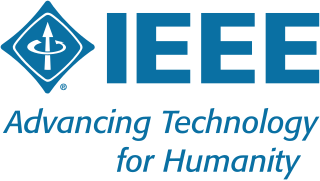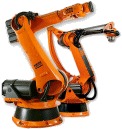
The Institute of Electrical and Electronics Engineers (IEEE) is a professional association for electronic engineering and electrical engineering with its corporate office in New York City and its operations center in Piscataway, New Jersey. It was formed in 1963 from the amalgamation of the American Institute of Electrical Engineers and the Institute of Radio Engineers.

Henryk Władysław Magnuski was a Polish telecommunications engineer who worked for Motorola in Chicago. He was a primary contributor in the development of one of the first Walkie-Talkie radios, the Motorola SCR-300, and influenced the company's success in the field of radio communication.
Vehicular communication systems are computer networks in which vehicles and roadside units are the communicating nodes, providing each other with information, such as safety warnings and traffic information. They can be effective in avoiding accidents and traffic congestion. Both types of nodes are dedicated short-range communications (DSRC) devices. DSRC works in 5.9 GHz band with bandwidth of 75 MHz and approximate range of 300 m. Vehicular communications is usually developed as a part of intelligent transportation systems (ITS).
The Vehicular Technology Conference (VTC) is a semiannual international academic conference on wireless communications. It is organised by the Institute of Electrical and Electronics Engineers' Vehicular Technology Society.
Vehicular ad hoc networks (VANETs) are created by applying the principles of mobile ad hoc networks (MANETs) – the spontaneous creation of a wireless network of mobile devices – to the domain of vehicles. VANETs were first mentioned and introduced in 2001 under "car-to-car ad-hoc mobile communication and networking" applications, where networks can be formed and information can be relayed among cars. It was shown that vehicle-to-vehicle and vehicle-to-roadside communications architectures will co-exist in VANETs to provide road safety, navigation, and other roadside services. VANETs are a key part of the intelligent transportation systems (ITS) framework. Sometimes, VANETs are referred as Intelligent Transportation Networks. They are understood as having evolved into a broader "Internet of vehicles". which itself is expected to ultimately evolve into an "Internet of autonomous vehicles".
The IEEE Nuclear and Plasma Sciences Society (NPSS) is a transnational group of about 3000 professional engineers and scientists. The IEEE-affiliated Society sponsors five major annual, and 12 biennial conferences and symposia. It also sponsors or co-sponsor four peer-reviewed academic journals.

The following outline is provided as an overview of and topical guide to automation:
The IEEE Industrial Electronics Society (IES) is one of the 39 Society of the IEEE. It is one of the oldest societies within IEEE with its roots going back to the early 1950s. The focuses of this Society are on the theory and application of electronics, controls, communications, instrumentation, and computational intelligence to industrial and manufacturing systems and processes. The society oversees the publication of three scientific periodicals that are consistently listed in the top 500 journals worldwide annually ranked according to their impact factor.
The IEEE Circuits and Systems Society is a society of the Institute of Electrical and Electronics Engineers (IEEE). It is also known by the acronym IEEE CASS. In the hierarchy of IEEE, the Circuits and Systems Society is one of almost 40 technical societies organized under the IEEE's Technical Activities Board.

The IEEE Communications Society (ComSoc) promotes the advancement of science, technology and applications in communications and related disciplines. It fosters presentation and exchange of information among its members and the technical community throughout the world. The Society maintains a high standard of professionalism and technical competency. The IEEE Communications Society is a professional society of the IEEE.
IEEE Computer Society is a professional society of the Institute of Electrical and Electronics Engineers (IEEE). Its purpose and scope is "to advance the theory, practice, and application of computer and information processing science and technology" and the "professional standing of its members." The CS is the largest of 39 technical societies organized under the IEEE Technical Activities Board.
IEEE Transactions on Communications is a monthly peer-reviewed scientific journal published by the IEEE Communications Society that focuses on all aspects of telecommunication technology, including telephone, telegraphy, facsimile, and point-to-point television by electromagnetic propagation. The editor-in-chief is Tolga M. Duman. According to the Journal Citation Reports, the journal has a 2018 impact factor of 5.69.
The IEEE Signal Processing Society is a society of the IEEE. It is also known by the acronym IEEE SPS. In the hierarchy of IEEE, the Signal Processing Society is one of close to 40 technical societies organized under the IEEE's Technical Activities Board. The IEEE Signal Processing Society is IEEE's first technical Society.
The IEEE Electronics Packaging Society is a professional society of the IEEE that deals with the advancement of microsystems packaging and manufacture.

The IEEE Education Society (EdSoc) is a society of the Institute of Electrical and Electronics Engineers (IEEE) that is focused on the theory and practice of education and educational technology needed to deliver effectively domain knowledge in the fields of interest of IEEE. The society is an international organization concerned with state-of-the-art information and resources related to engineering education and with professional development within academia and industry. Membership is open to professionals in an IEEE-designated field as evidenced by educational background or by experience as well as to students who are pursuing undergraduate or graduate education in an IEEE-related field.
The IEEE Electron Devices Society is a professional society of the IEEE.
The IEEE Intelligent Transportation Systems Society (ITSS) is a professional society of the IEEE.
The IEEE Robotics and Automation Society is a professional society of the IEEE that supports the development and the exchange of scientific knowledge in the fields of robotics and automation, including applied and theoretical issues.
Prosa Structured Analysis Tool is a visual systems and software development environment which supports industry standard SA/SD/RT structured analysis and design with real-time extensions modeling method. Prosa supports data flow diagrams, state transition diagrams and entity relationship diagrams using Chen's and Bachmans ER notations. Prosa has integrated data dictionary.




